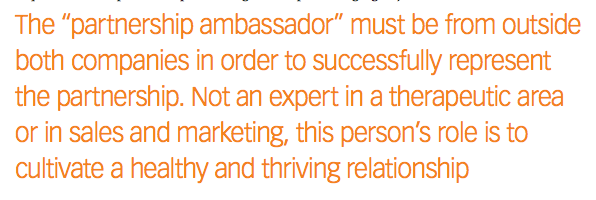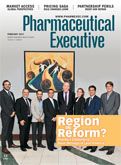The Trouble with Pharma Partnerships ... And How to Fix Them
A new approach to reviving industry collaborations.
Partnerships enable pharmaceutical companies to gain expertise, leverage more resources, and reduce risk. By sharing expertise, resources, and profits, such business ventures have the potential to return significant value. In a study conducted by the CMO Council, 85% of those surveyed said partnerships and alliances are essential or important to their business. Yet almost half reported failure rates of 60% or more.
With so much at stake, pharma companies have developed detailed governance models with joint steering committees and escalation procedures to try to keep the peace between partners. Unfortunately, these structures and procedures are often flawed and are akin to a pre-nuptial agreement. They don’t help the partnership maintain alignment and stay together; they simply attempt to pre-define how to resolve expected conflicts and in the worst case, determine who gets what when a breakup occurs.
Most companies in partnerships employ alliance directors who are responsible for maintaining their partnership. The first problem with this structure is that most alliance directors are not dedicated to one brand, making it difficult to be sufficiently engaged with all aspects of the brand to maintain alignment and prevent issues. The second problem is that these alliance directors are personally and professionally aligned to their respective company, so when problems become serious enough that they get involved, they do so through the lens of what’s best for their company as opposed to what’s best for the partnership.
Instead, what’s needed is an approach that puts communication and trust at the center of the partnership. One critical component of this approach is the appointment of a “partnership ambassador” who is aligned to the partnership rather than to the individual companies involved.
How things fall apart
Pharma organizations are incredibly complex. Partnering firms, and the different departments within them, often have their own unique agendas. Often the objectives of different functions and departments within a single organization can be at odds with one another. Add another company to the mix and the risk of misalignment of objectives grows exponentially.
Drugmakers invest enormous amounts on their key brands, but invest surprisingly little to keep their partnerships healthy. If steps aren’t taken to keep the objectives of the partnership aligned, fissures that develop in the relationship through the natural breakdown of alignment grow into serious cracks. These result in a breakdown in trust-and without trust, any partnership is guaranteed to fail.
Many of us who have been a part of partnerships have experienced how a breakdown in trust can tear a partnership apart. I experienced this with one of the brands that I co-managed. The brand was nearing the end of its patent life and, therefore, the end of the partnership agreement. Through a technicality, we believed that we could extend the life of the brand beyond the partnership. This set up a misalignment of objectives in that we received higher value from continued investment in the brand while our partner received higher value by cutting investment. As the dominant partner, we insisted on continued high investment.
The misalignment of objectives, combined with other complexities, led to a termination of the partnership in one of the key countries when the partner failed to deliver on our dictated level of investment. This caused the partner to lose about $25 million. Six months later we suffered a loss of reimbursement in that same country, which caused us to incur similar losses. One of the areas of strategic value that our partner had brought to the table was its strong relationship with the payer authority in that country. That relationship would likely have helped us retain reimbursement for the brand.
The power of personality
In the above example, the losses could have been worse. We were able to keep the partnership together in the remaining countries, despite this traumatic event. That said, we could have avoided significant loss of value if we had trusted each other, understood each other’s changed objectives, and worked toward a solution that was in the best interests of the partnership while still amicable to both organizations.
Planning for change
Partnership agreements do try to anticipate changes in advance by incorporating adjustment clauses. These recognize that the value each company brings to the partnership can change over time. When the partnership gets out of balance, an adjustment-usually financial-can be made. More difficult is when the objectives of the respective partners change and are no longer aligned, like in the example described. If the partners cannot adjust and align on new objectives, the partnership is likely to fail.
At pharmaceutical companies, significant events might include a drug coming off patent, product portfolio changes, and divesting or merger and acquisition activity that contracts or expands the available sales and marketing staff. In such situations, company objectives are bound to change and the partners may no longer be aligned. Yet, instead of addressing the change, teams tend to focus on the day-to-day issues of their brand with little attention to keeping the partners in sync.
A prescription for success
Partnerships, like any relationship, require attention and trust to thrive. It is best practice to bring stakeholders together when a partnership is formed to ensure alignment on key objectives, establish ways of working, etc. We have seen great success in multi-day immersive sessions where team exercises generate dozens of actionable ideas, then the participants take the ideas further by developing clear action plans: identifying, agreeing on, and assigning next steps. What might otherwise take months to accomplish can be done within days.
What pharmaceutical companies have failed to recognize thus far is that these initial sessions are a great start, but not nearly enough. Achieving success requires that partnership sessions be held on a regular basis. It also requires that the partnership have a strong independent voice that is not conflicted by the pressures that arise from each company’s broader organizational objectives and shifting agendas.
A new approach to achieving and maintaining a successful partnership includes appointing a partnership ambassador. This person must be independent of the respective companies and embedded as an active member of the team and report to the partnership’s joint steering committee.
The ambassador must be from outside both companies in order to successfully represent the partnership. Not an expert in a therapeutic area or in sales and marketing, this person’s role is to cultivate a healthy and thriving relationship. The ambassador must be trusted by both partners to act in the best interests of the combined entity.
Trust is the operative word. Free from hidden agendas and favoritism, the ambassador’s role is to ensure that open communication fosters understanding and allows for effective decision making. He or she is an independent voice that regularly

takes the partnership’s temperature, communicates back and forth effectively, clarifies issues, and facilitates compromise.
Like a preemptive marriage counselor, the ambassador can help the parties make adjustments that enable the partnership to grow despite changing objectives. This individual must have a slot on the agenda at face-to-face meetings over the lifetime of the agreement. By maintaining a focus on the relationship, the ambassador ensures alignment and that issues are addressed early on and continuously. The role is not empowered to make changes, but is a facilitator to move things forward, with a vested interest in the health of the partnership.
It’s never too late
But what if your company has a partnership that is already at risk due to diverging objectives and a lack of ongoing alignment?
It is possible to reset a partnership with much of the same principles as outlined.
Companies spend huge sums of money to develop and market new pharmaceutical brands through partnerships. It is simply shortsighted not to invest a modest amount on the relationship to keep their partnerships aligned and thriving.
Keith Bailey is a Principal in the Life Sciences Division of Capgemini Consulting. He can be reached at Keith.Bailey@capgemini.com

The Misinformation Maze: Navigating Public Health in the Digital Age
March 11th 2025Jennifer Butler, chief commercial officer of Pleio, discusses misinformation's threat to public health, where patients are turning for trustworthy health information, the industry's pivot to peer-to-patient strategies to educate patients, and more.
Navigating Distrust: Pharma in the Age of Social Media
February 18th 2025Ian Baer, Founder and CEO of Sooth, discusses how the growing distrust in social media will impact industry marketing strategies and the relationships between pharmaceutical companies and the patients they aim to serve. He also explains dark social, how to combat misinformation, closing the trust gap, and more.